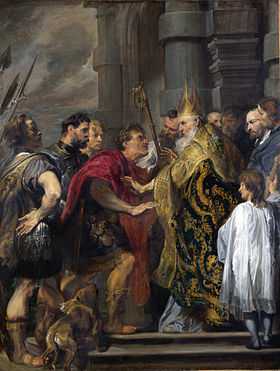390
| Millennium: | 1st millennium |
|---|---|
| Centuries: | 3rd century – 4th century – 5th century |
| Decades: | 360s 370s 380s – 390s – 400s 410s 420s |
| Years: | 387 388 389 – 390 – 391 392 393 |
| 390 by topic | |
| Politics | |
| State leaders – Sovereign states | |
| Birth and death categories | |
| Births – Deaths | |
| Establishment and disestablishment categories | |
| Establishments – Disestablishments | |
| Gregorian calendar | 390 CCCXC |
| Ab urbe condita | 1143 |
| Assyrian calendar | 5140 |
| Bengali calendar | −203 |
| Berber calendar | 1340 |
| Buddhist calendar | 934 |
| Burmese calendar | −248 |
| Byzantine calendar | 5898–5899 |
| Chinese calendar | 己丑年 (Earth Ox) 3086 or 3026 — to — 庚寅年 (Metal Tiger) 3087 or 3027 |
| Coptic calendar | 106–107 |
| Discordian calendar | 1556 |
| Ethiopian calendar | 382–383 |
| Hebrew calendar | 4150–4151 |
| Hindu calendars | |
| - Vikram Samvat | 446–447 |
| - Shaka Samvat | 312–313 |
| - Kali Yuga | 3491–3492 |
| Holocene calendar | 10390 |
| Iranian calendar | 232 BP – 231 BP |
| Islamic calendar | 239 BH – 238 BH |
| Julian calendar | 390 CCCXC |
| Korean calendar | 2723 |
| Minguo calendar | 1522 before ROC 民前1522年 |
| Seleucid era | 701/702 AG |
| Thai solar calendar | 932–933 |
| Wikimedia Commons has media related to 390. |

Year 390 (CCCXC) was a common year starting on Tuesday (link will display the full calendar) of the Julian calendar. At the time, it was known as the Year of the Consulship of Augustus and Neoterius (or, less frequently, year 1143 Ab urbe condita). The denomination 390 for this year has been used since the early medieval period, when the Anno Domini calendar era became the prevalent method in Europe for naming years.
Events
By place
Roman Empire
- April – Massacre of Thessalonica: Resentment among the citizens of Thessalonica (Macedonia), after the arrest of a popular charioteer, breaks out into violence. Butheric, military commander of Illyricum, is murdered. Emperor Theodosius I orders vengeance, despite the pleas of Ambrose, bishop of Milan, for mercy, and more than 7,000 inhabitants are massacred by the Roman army.
- Ambrose retires to Milan (residence of Theodosius I) and refusing to celebrate a mass in the emperor's presence, until he repents for ordering the massacre in Thessalonica. Theodosius filled with remorse, kneels in humility and strips of his royal purple, before the altar of the cathedral in Milan, humbling himself before the Christian church.
- The Visigoths and Huns, led by Alaric, invade Thrace. Stilicho, high-ranking general (magister militum) of Vandal origin, raises an army and begins a campaign against the Goths.
- Theodosius I brings an obelisk from Egypt to the Hippodrome of Constantinople.
India
- Rudrasena II becomes emperor of Vakataka in the Deccan Plateau (India). In the same year he marries Prabhavatigupta, daughter of the Gupta king Chandragupta II.
By topic
Art
- C. 390–401 – Priestess of Bacchus: Late Antiquity ivory diptych; documents the relationship of the senators Quintus Aurelius Symmachus and Virius Nicomachus Flavianus. It commemorates the marriage of the two families. The right panel is inscribed "Symmachorum", with an elaborately dressed priestess who makes an offer on an altar. It is now kept at Victoria and Albert Museum in London.
Religion
- Jerome, having finished the Latin translation of the New Testament, begins translating the Old Testament.
- The Kama Sutra is revised by Vatsyayana.
Births
- Bleda, king of the Huns (approximate date)
- Gao Yun, duke of the Xianbei state Northern Wei (d. 487)
- Prosper of Aquitaine, disciple and Christian writer (approximate date)
- Romanus of Condat, hermit and saint (approximate date)
- Simeon Stylites, Christian Stylite (approximate date)
- Xie Hui, general of the Liu Song Dynasty (d. 426)
Deaths
- Apollinaris of Laodicea, bishop and theologian
- Aurelius Victor, Roman historian and politician
- Chen Guinü, queen consort of Jin Xiaowudi
- Diodorus of Tarsus, bishop and monastic reformer